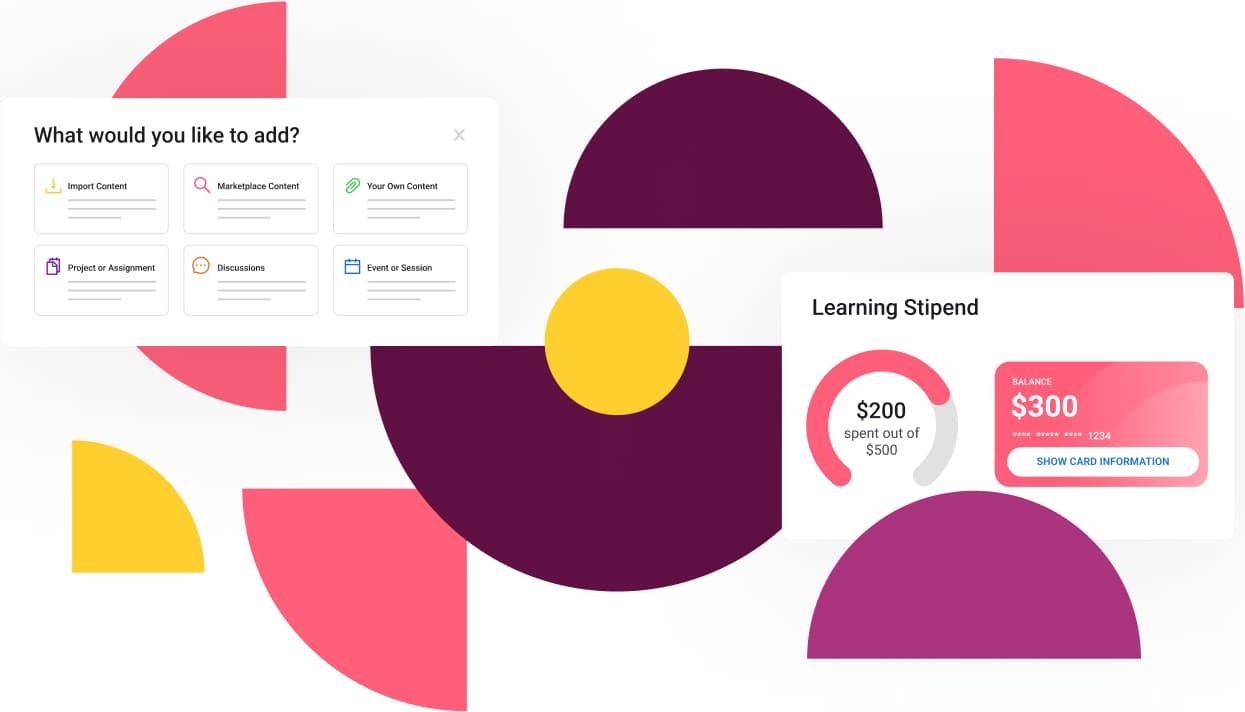6 Big Trends In Talent Development and Actions You Can Take Today
Recently I partnered with Jen Collins of the Learning Cluster Design Group to discuss 6 Big Trends in Talent Development. During the session, we covered a lot of ground discussing what’s needed for employees to help them thrive and be excited to learn, while ensuring that the learning is beneficial for the business. If you’d like to view the session, you can access the recording here.
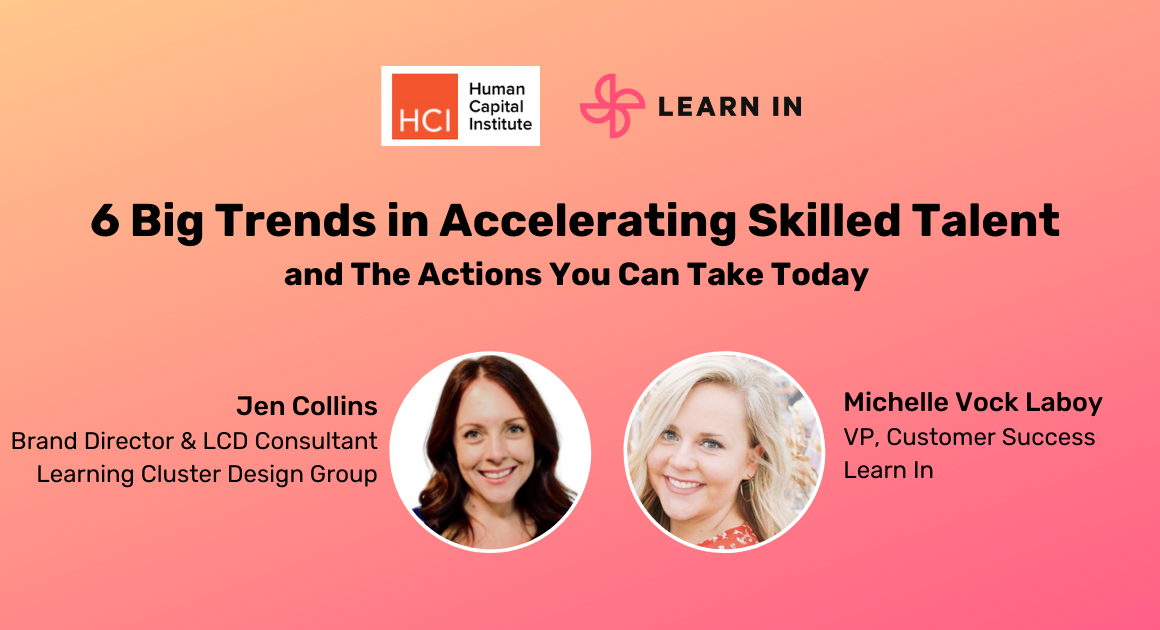
This quote from Adam Neumann, ex-founder of WeWork caught my eye recently,
“The future of work looks different, there is a new generation out there. They don’t dress like their parents. They don’t work like their parents. They don’t think like their parents. Why would they want their parent’s offices?”
Adam Neumann
And while he might be a polarizing figure, I think there is real truth to this idea, especially when it comes to expectations of employees today – which is significantly different even from the pre-pandemic days.
We started the discussion with thoughts from attendees about how they define a modern workforce. Here’s what they told us:

So then the question is really: How do we enable the Modern Workforce? Which is really our first trend also and an umbrella of all the trends that follow. As we can see from the word cloud above, a modern workforce for one team might be significantly different for another team, and what they need in order to meet their talent needs as well as their business goals may be a little bit different too. A big part of this trend is that we are seeing learning and development teams moving away from being an order taker to a business partner. We can take a more consultative approach understanding the business and how to help employees in the flow of work in every work environment.
And what if we don’t adapt to this demand? Our biggest risk is that we’ll lose out on amazing talent and the ability to grow our business. We are in an employee’s market right now. Maybe that gives us the license and opportunity to catch up with technology investments that slowed down over the past few years so that we can be more learner-centered, offering higher quality choices, focused on skill-building while being aligned to career goals.
To get on top of what this trend means for your business, here’s what you can do today:
- Interview 5 employees from various teams/generations and ask them (1) what learning and growth means to them and (2) what they want from their employers
- Audit one of your learning programs and try to identify one way in which you can upgrade the experience to support Modern Learning
- Ask discipline leads how they are staying up-to-date with trends and skills outside of formal learning to leverage some of the tactics they are already using
Trend 2: Inclusive & Accessible
Historically, learning and development and DE&I efforts have been somewhat separate and siloed, but there’s a trend emerging to have every touch point in all of our learning programs more inclusive and then by consequence it’s also then more accessible. For example, we can make sure that there are resources for our employees when they need it the most. So, if they’re going through and they’re getting ready to have a performance discussion, how do you make sure that the resources that they may need are easily at their fingertips, maybe in a central location where all of your materials and resources and assets can be saved.
Here’s what you can do today in both these areas:
- Inclusive: Hold yourself accountable through data. Who in the company is actually learning? Can you see the total spend by each employee? By demographic or department? Who is getting the most or least?
- Accessible: Make your learning resources more accessible and top of mind through performance discussions, providing a landing page will all of the resources available and schedule of live events, having SMEs serve as a sounding board for tough conversations, and providing job aides to increase awareness of biases
Trend 3: Beyond the One-and-Done
Historically we have been focused on creating a single course or a single program but what we know through the research is that learners are finding ways to learn daily, weekly and oftentimes on their own. Just think about the last time you learned something outside of work and what that experience was like, maybe you started with a YouTube video, then read an article or consulted with a neighbor or a friend or you went to Google and looked up FAQs, whatever method and mode, all of those tactics in one way shape or form over time shaped your learning – it is what’s called Learning Cluster Design or, in other words, a way to surround your learner with meaningful assets both in and out of the flow of work. Another term for this is modern digital learning academies. So, as we think about moving beyond one single touch point or one single tactic course or program that we’re going to execute, we need to think about how we are giving them multiple assets in order to support their development and to drive lasting impact. It’s not an event, but a journey.
In every employee’s journey there are key moments of learning (see image below). It might start with onboarding, then you get a new project assigned, then you have a key initiative and you know how to prepare for that next role and then a promotion. Performance reviews also play an important role in defining the key learning moment.
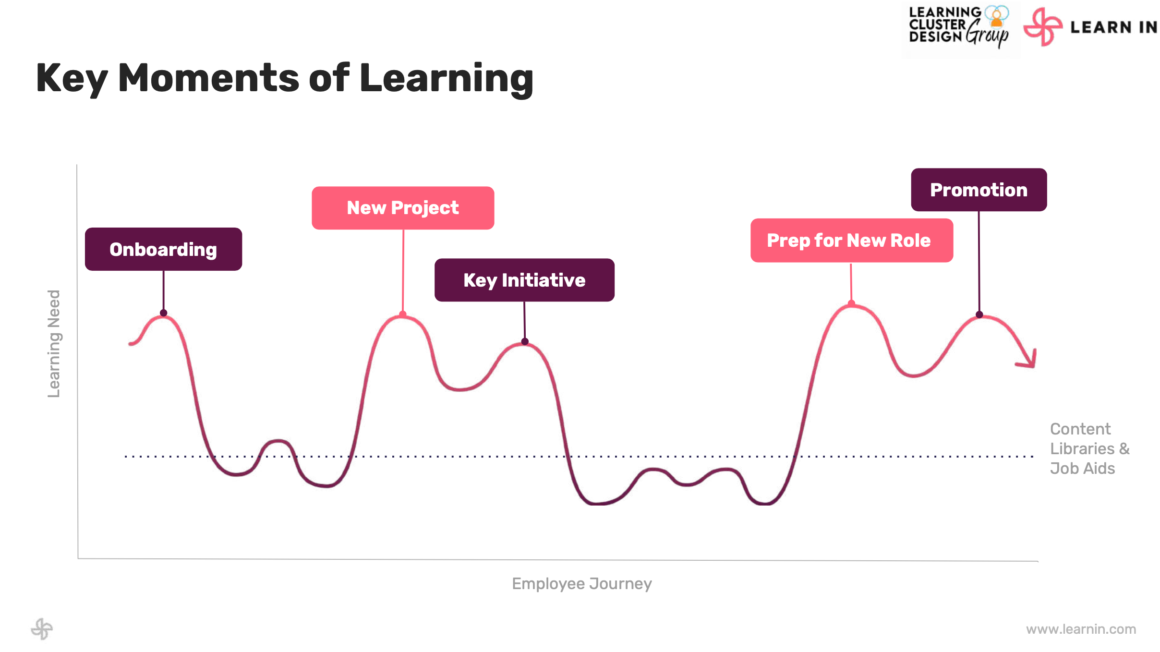
So what can you do today to incorporate this trend inside of your workstreams? Some ideas include:
- Creating a learning academy can have a phased approach:
- Phase 1: Organize – Bring all assets together in one place like a folder
- Phase 2: Analyze – Look at all the assets you have, see what needs to be updated, and look where there are skills gaps
- Phase 3: Orchestrate – Use a tool like Learn In Academies or partner with Learning Cluster Design to bring everything together as a user experience that’s simple, curated, customized, and measurable
- In the Learning Cluster Design Model, you would use the following touchpoints:
- Formal: Class or course
- Immediate: On-demand (recordings, chunked content based on topic)
- Social: Peer-to-peer – assigned buddy to practice. Monthly discussions to collaborate on how things are going
Trend 4: Learner Centered Solutions
By now we should all recognize that one size fits all learning just doesn’t work. Take Netflix for instance or any other streaming platform. What’s so unique about these platforms is that not only are they curating content that’s very specific to what the viewer wants. So, I get apocalyptic movies and musicals more frequently than someone who may be more interested in documentaries or rom-coms or sci-fi. Further, they customize the artwork on the tiles to encourage clicks anywhere from five to twenty different visuals that they may use for a single movie. Behind the scenes they’re using an algorithm and A.I. in order to identify what are the shows that you’re binging that are making you click on specific ones to make you watch more and watch longer.
In the same way, we need to be much more learner-centered. As part of the Learning Cluster Design (LCD) model it is important to understand personas first and then learner differences. We can then work out how to provide assets for both learning clusters as well as solutions to help those specific learners in their flow of work and make sure we’re customizing our solutions to support them on the job. Two innovations here include precision funding of programs where there are skill gaps to drive the behavior of actually taking relevant programs by issuing learning stipends. It’s really a modernized approach to the old tuition assistance programs. We work closely with a company that gives everybody $3,000 dollars which allows employees to really take the wheel of where they want to go in their careers as they can access a marketplace of options like day-long boot camps or 12-month programs. This allows everyone to customize their approach based on their time commitment and based on their approach that they like to take for learning and kind of what they think they need to to grow in their own professional careers within the company. We recommend they meet with their managers to kind of figure out what they’re going to learn so it syncs with the business.
One step you can start today is to create large and small learning cohorts to give customized and personalized experiences. The LCD or academy model focuses on creating learner personas. For example, in many organizations the onboarding experience is one-size-fits all, but the reality is, there are a few different groups you should be designing for: (1) new to the organization (2) new to the team, transfer from the within – they already understand the organization (3) seasoned professional vs new graduate, etc.
Trend 5: Collaborative & Crowdsourced
Something I’m continuing to hear is about being more collaborative and crowdsourced. When a learning leader is ready to design a program or academy sometimes they forget that the best teachers are you know right under their nose. These are employees who have been there for a while; they’re looking for ways to step up and lead. It is time to tap your own team. It will enable a more agile process for producing content and finding instructors. Here’s a few thoughts to get you moving ahead immediately:
- Leverage SMEs within your organization to create a one-pager or FAQ
- Have target learners create content, and provide examples during their learning experience that you can use to guide future learning events
- Use the onboarding checklist created by the business lead and use it as a base for your formal learning program
- Create a living document or Slack/Teams channel for people to add examples. For example, sales prospecting emails, best practices, good examples, critiques, etc.
Trend 6: Adaptive & Progressive
Our final trend is about being adaptive and progressive. We need to be flexible to changing situations. Sometimes we’re forced to do that, like what we’ve all been through in the past two years, and needing to really show up for our talent. Progressive is really about identifying and taking a tiered approach to how we are really moving to enabling this modern workforce and enabling modern learning. To be successful in integrating this trend we need to empower ourselves, potentially through professional development, and be efficient, borrowing ideas, and starting small without boiling the ocean.
One thing to think about is how to build the perfect modern learning team which essentially boils down to four key capabilities:
- learning strategist who can tie efforts to business impact and be clear about performance objectives – a term that we use with the learning cluster design;
- learning designer who can build programs that are inclusive and learner-centered moving beyond one and done events.
- a marketing and communications specialist is a vital role too. We spend a lot of energy building amazing programs and then we send one email out to talk about it. How can we use multiple touch points and mechanisms to nudge learners towards the resources that are available to them Plus, show them how they can continue to practice on the job.
- a data analyst to connect our efforts back to business impact and key performance indicators that we should be looking at
One step to take right now is to invest time for your own professional development and create your own learning cluster to develop your capabilities. Keep learning!
Here are the trends in full:
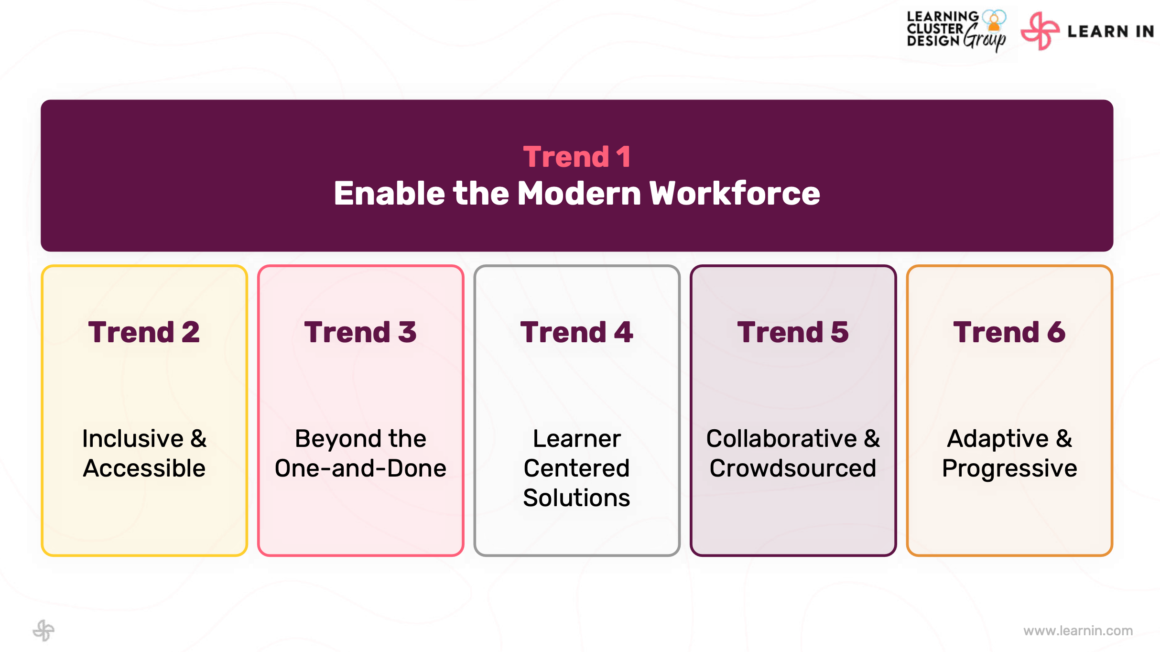
Let me know if you have any questions about any of the points covered, I’m always happy to discuss or connect!
Written By: MICHELLE VOCK LABOY, VP CUSTOMER SUCCESS, Learn In
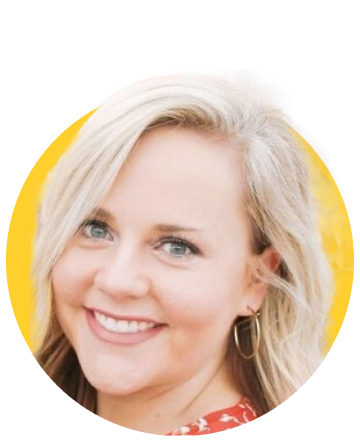
About Learn In
Learn In helps companies establish talent academies that steer all the resources needed for building an always-skilled workforce. HR, Talent and L&D leaders use Learn In to modernize access to learning budgets and world-class programs, and to simplify the delivery of custom programs to employee groups. Learn In’s core features include a tuition benefits manager, a prepaid learning stipend card, a world-class program marketplace and custom program builder, and dedicated coaching. Now every employee can build deeper skills precisely aligned to company needs. Co-founded by the founders of Degreed, Learn In is backed by leading edtech & future-of-work investors, including Firework Ventures, Kickstart Fund, GSV, Album, and Village Global, and has been covered in CNBC, USA Today, EdTechReview, EdSurge, and Techcrunch.
For more insights, follow us on LinkedIn, or subscribe to our newsletter to stay in touch.
